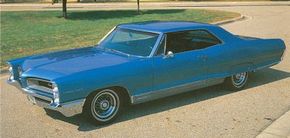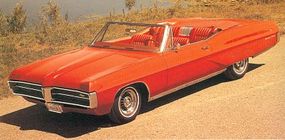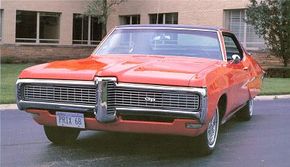After three successful years, the 1965-1968 Pontiac Grand Prix entered a four-year sales decline that reflected a general decline in the car itself. Actually, there was nothing wrong with the 1965-68 models that a visit to Weight Watchers wouldn't fix, and if more glitter and gadgets were evident, so was more power that enabled performance to remain respectable.
These GPs were clearly less special than the handsome and balanced 1962-64s, a fact evidently not lost on the public. From a high of 12.4 percent for 1963, Grand Prix skidded to just 4.4 percent of total Pontiac sales by 1966 -- a record year for the division as a whole. The '68 figure was an equally lackluster 4.6 percent.
Advertisement
This fall in fortunes largely stemmed from two related factors: the advent of mid-size performance cars like Pontiac's own GTO, and a consequent waning interest in sporty big cars like the Grand Prix. Price was not a factor. Despite a bigger, all-new design, the '65 base-priced a dollar less than the '64 -- exactly $3,498 -- and by '68 the sticker was up by less than $200 despite interim inflationary pressures.
Inflated certainly described Pontiac's '65 styling, which contrived to make its wares seem much larger than any dimensional gains suggested. Indeed, GP wheelbase was stretched only an inch, to 121, and just 1.6 inches were added to overall length, though the resulting 214.6 inches were hardly what one would call trim. Curb weight was little affected, too, remaining at just under two tons.
Nevertheless, the '65 GP and its cohorts looked like bodybuilders on steroids: bulged and billowed all over the place in the curvy, humped-fender idiom GM hoped to popularize. About all that remained of previous Grand Prixs were the trademark split-theme grille, stacked quad headlamps, discreetly hidden taillamps, and unique roofline with concave rear window.
Happier news awaited underneath. Like GM's other B-body full-size cars that year, the '65 Pontiacs adopted a stronger new full-perimeter chassis that was more resistant to side impact damage than the previous X-member design.
Another advancement came as the old never-liked Roto Hydra-Matic transmission gave way to the vastly superior new Turbo Hydra-Matic with enlarged torque converter. Engine choices still comprised a quartet of 389s and a trio of big-block 421s, but power ratings were up across the board. The standard 389, for instance, gained 22 horsepower for a total of 325, and 421s offered up to 376 with optional Tri-Power carburetion.
Helped in no little measure by the new automatic, the base-engine '65 proved quicker than its '63 counterpart by nearly three seconds in the 0-60 dash, according to Motor Trend -- a 27 percent improvement. Braking suffered, though -- by a substantial 44 feet in 60-mph "panic" stops.
Other things suffered, too. A bench seat was standard in lieu of buckets, which now cost extra, and upholstery switched from vinyl to cloth. In short, the GP was turning from sports-luxury to personal-luxury. But Ford's Thunderbird and Buick's Riviera were knocking each other over for king of that hill; GP evidently wasn't seen as a contender.
Despite Pontiac's best intentions, sales of the 1965-1968 Grand Prix were rather lackluster. Go to the next page to find out more.
For more information on cars, see:
- Classic Cars
- Muscle Cars
- Sports Cars
- Consumer Guide New Car Search
- Consumer Guide Used Car Search
Advertisement



